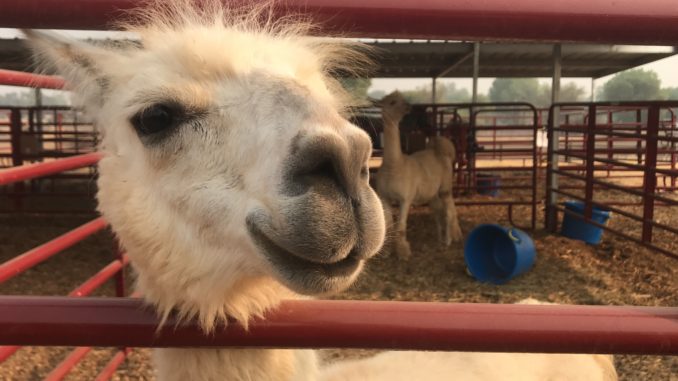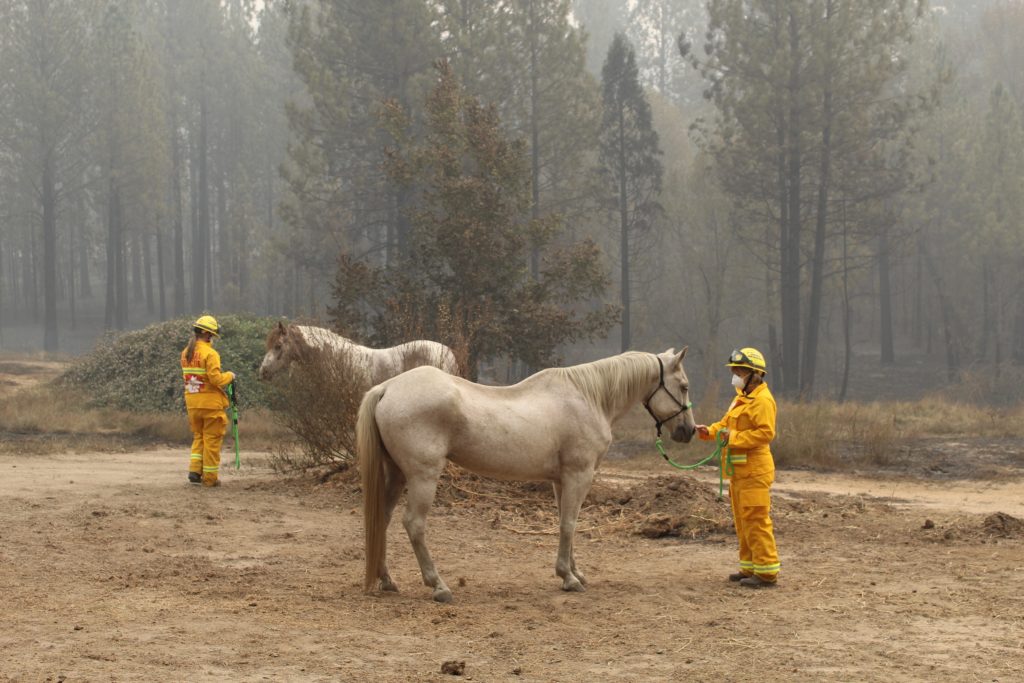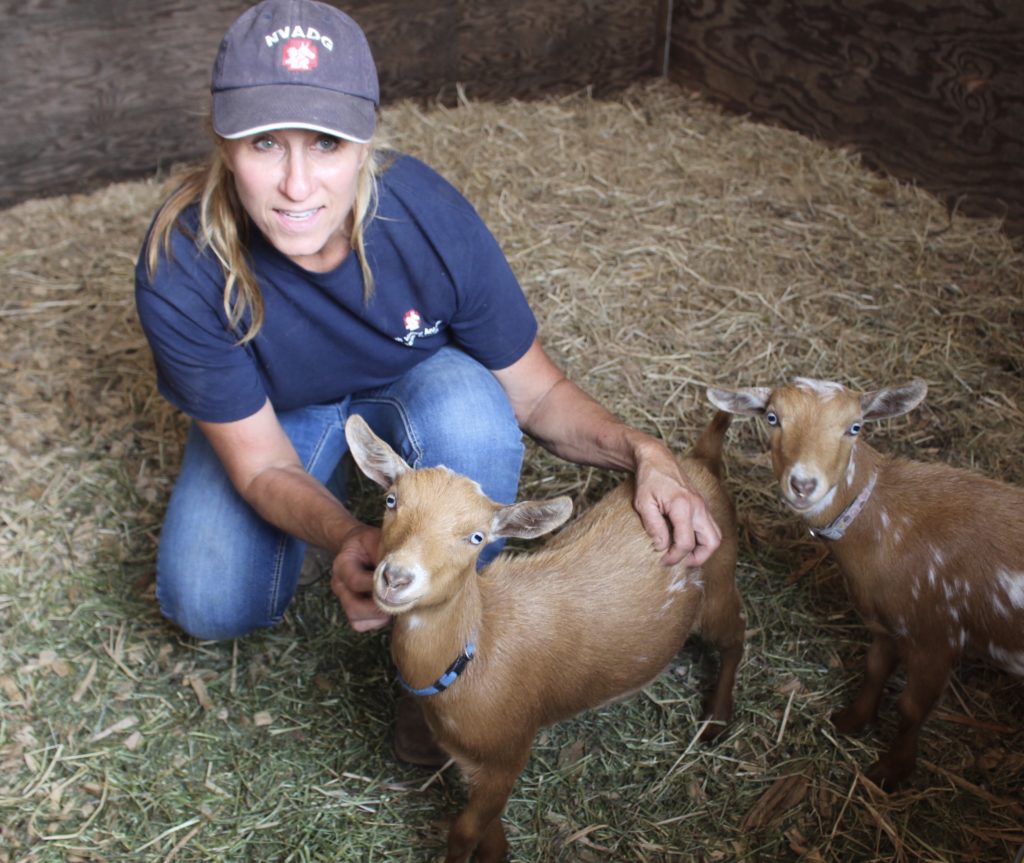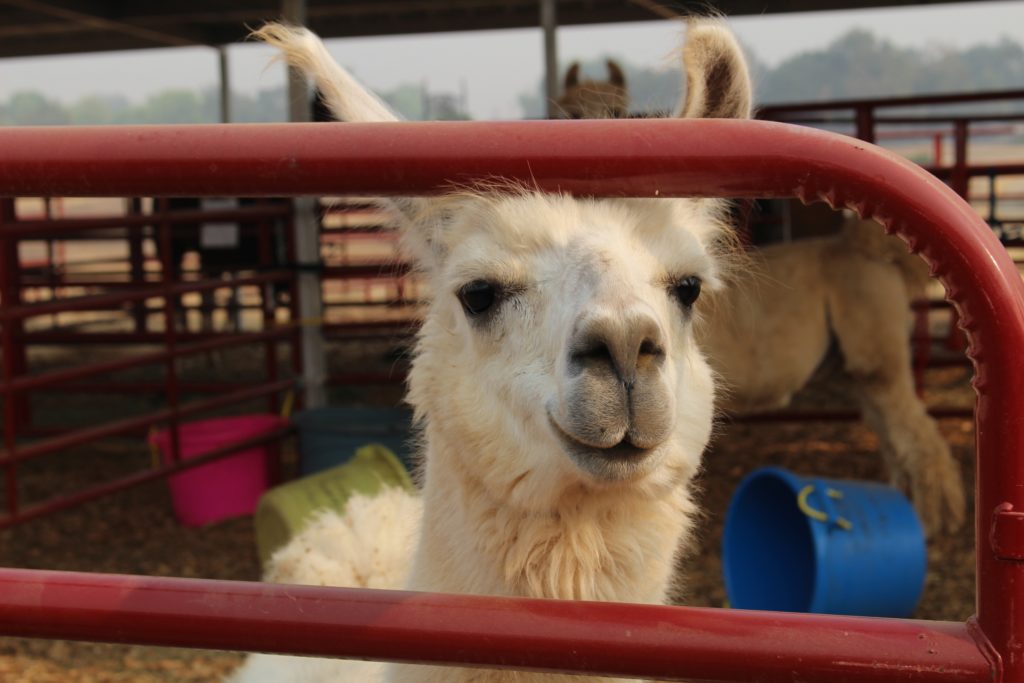
The only wildlife spotted by CN&R reporters during a Sept. 10 trek into areas ravaged by the North Complex Fire were a pair of ravens ominously perched on a guardrail near the Bidwell Bar Bridge; a single squirrel scurrying along the charred roadside; and a fallen deer—the apparent victim of smoke inhalation. The sounds of twittering birds, chattering creatures and distant barking dogs usually common in the mountain community of Berry Creek were absent, imbuing the still-smoldering forest with an element of devastation impossible to capture in pictures and news footage: unnatural silence.
In that landscape, the sight of two horses trudging around a smoky, corralled meadow on Bald Rock Road was enough to spur calls for help from first responders who, for all their bravery, training and resources, are unequipped to deal with such an emergency. Situations like these call for a special kind of hero, and that’s when volunteers from the North Valley Animal Disaster Group (NVADG) are called in.
“We definitely got multiple calls on these guys—from the sheriff’s department and Butte County and a few others,” said NVADG volunteer Merritt Clark after backing a large animal trailer into a tight-fitting driveway at the corral’s gate. “We’d heard that one of the animals was down earlier and that’s a bad sign, so it’s good to see both are up on their feet.”
Clark and fellow volunteer, Deborah Silcox, calmly made their way across the field, talking in soothing tones to silence the horses’ worried neighs. After a few minutes of gaining the animals’ trust with sweet talk and treats, the women gently led the horses to the trailer and—with a minimum of fuss—coaxed them in. After taking less than a minute to secure the second horse, Clark emerged from the trailer with a smile.
“That was amazing … it’s rarely that easy,” she said.
“Yeah, I think they really wanted to get out of here,” Silcox added. “It looks like they’ve had a rough time.”

Clark nodded affirmatively, noting the older of the two horses was showing signs of smoke inhalation. It’s an informed assessment as Clark, who lives in Winters, is a vet tech with multiple degrees in animal science (“I actually have a degree in horses,” she quipped). She’s been with NVADG since 2018, and was first deployed during the Camp Fire. She worked that fire alongside Silcox, from Folsom, who has been with the organization since 2015 and joined up during Lake County’s Valley Fire.
After leaving a note for the owners regarding the horses’ destination, the duo disappeared as fast as they arrived, bound for NVADG’s large-animal shelter for North Complex evacuees located at Camelot Equestrian Park in Butte Valley. There, the horses would be assessed by veterinarians, corralled, fed and otherwise cared for—all free of charge—until their owners are able to reclaim them.
Organized chaos
The scene at Camelot the following afternoon (Sept. 11) was a stark contrast to that of the silent, largely lifeless foothills affected by the fire. Dozens of temporary corrals housing all manner of barnyard animals stretched out in every direction, bleating sheep and grunting pigs sounded from the stalls of a large barn and dozens of volunteers rushed about feeding animals and mucking their enclosures.
“It really does take a village of people to make this happen,” said NVADG’s Lori Grande amid all the hubbub.
In addition to the large-animal center, the all-volunteer organization is also operating a small-animal shelter during the North Complex Fire, with hundreds more animals—including dogs, cats, fish, birds and reptiles—currently housed at Old Country Animal Hospital in Oroville.
NVADG is a nonprofit that operates under the oversight of Butte County Animal Control, but is non-government funded. It was founded in September 2004 as part of the state’s directive for counties to establish disaster plans for animals following devastating floods in Northern California in 1997. When not responding to disasters, the group does outreach to local communities encouraging people to incorporate the evacuation and well-being of pets and farm animals into their family’s disaster plans.

Grande, the large-animal site’s manager and an 11-year NVADG veteran, estimates that there are roughly 150 volunteers in the organization, with dozens working at each of the current evacuation facilities around the clock. Extraction teams number about 30 people, she said, and operate during daylight hours as safety precautions prohibit them from entering restricted areas after dark.
A steady stream of trucks pulling trailers—driven by both NVADG extraction crews and evacuated citizens—delivered more temporary residents to the shelter. A whiteboard with a census taken at noon that day accounted for 88 equines; 52 goats; 52 chickens; 13 sheep; 10 peacocks; eight turkeys; five pigs; two bovines; two llamas; one duck and a zebra, for a total of 234 animals. A volunteer noted that number had changed a great deal in the past three hours, with a few animals reclaimed by owners and dozens more added to the population.
“You just missed the zebra,” said Billy Lancaster. He and his wife, Jennifer, lost their home above Loafer Creek on the day the Bear Fire made its way into Butte County (Sept. 8), having evacuated with their four dogs, three cats and three “old rescue horses.” Their animals are being housed on a friend’s property, but the couple—who own Oroville’s Advanced Soil and Garden Supply—was at Camelot to deliver a donation of roughly 2,000 pounds of animal feed.
“The zebra’s owner came and picked it up, along with a Clydesdale,” Lancaster continued with a laugh. “It was quite a pair, two animals you’d never expect to see together.”
Grande said NVADG was activated the evening of Sept. 8, and that there was already a line of vehicles waiting to drop off animals when the Camelot location opened to evacuations the next morning.
Most of the animals that have been evacuated to this site are unharmed, but many suffered from burns, smoke inhalation, and lacerations from damaged fencing or being loaded into trailers under duress. All animals are given a veterinary appraisal upon arrival, with NVADG partnering with other groups, like the Northern California Association of Equine Practitioners on-site that day, to deliver that care. Animals with the worst injuries are taken to the UC Davis Veterinary Medical Teaching Hospital in Davis.
While at the facility, the animals are cared for and closely monitored to assure they stay healthy.
“Every animal has a care schedule, and we do a health check every time we feed and water them.” Grande said. “We monitor their poop every time we clean their stalls as well, because that’s an important thing for animal owners to know. If animals are stressed, they can have trouble pooping, which can lead to colic and other health problems.”
Grande said that the sheer amount of animals at the site and necessarily makeshift accommodations can stress animals out, and that they encourage owners to find other places to house them as soon as possible.
“But, if they’re unable to, we’re glad to care for them as long as it takes.”
From the ashes
Victor and Connie Vasquez own the 10.5-acre Shooting Star Ranch, located between Palermo and Honcut. The couple decided to act proactively as the North Complex threatened Butte County. They evacuated their three horses, two donkeys and pair of llamas to the Camelot location before the situation became critical.

“We’re under evacuation warning,” said Victor, who was at Camelot checking in on his animals Friday. “We’re fairly close to Bangor and know that if the fire came over that hill we’d only have maybe 15 minutes to get the animals out, and that wouldn’t be enough time.
“The horses have no problem getting into a trailer. One of the donkeys is OK with it, the other not so much. But the llamas, they hate it, so we thought it best to get them out of there while we could.”
Vasquez praised the work being done at the shelter: “We’re really happy with this place. It’s clean, well-organized, they keep track of their water and food, and there’s enough room for them to walk around. They do everything that needs to be done to keep the animals safe and healthy.”
And, he revealed, the presence of one of his animals at the NVADG facility—a people-loving, nearly two-year-old llama—is particularly meaningful.
During the Camp Fire, the couple volunteered with NVADG themselves, using their truck and animal trailer to deliver food to stranded animals and extract those that they could. As the couple owns exotic birds, Connie is currently tending them as a volunteer at the small-animal shelter.
“There was a lady in Paradise who lost her llamas during the Camp Fire, and we found them all alive and got them out,” Victor continued. One of the llamas, it turns out, was pregnant, and soon after the fire gave birth to a baby, which the Vasquezes acquired.

“His name is Phoenix, because he came from the ashes … just like the bird,” Vasquez said. He admitted the llama’s legendary origin story and sweet nature has made him a particular favorite among family and friends. “He likes people so much we had to buy Wisdom, the bigger llama, to teach him how to be llama.”
Want to help? NorthValley Animal Disaster Group’s greatest need at the moment is cash donations. NVADG announced via Facebook Sunday (Sept. 13) that they are well-stocked on small-animal supplies. As of Monday, the only donations of goods accepted at the large-animal site are commercially available feed, hay and chicken scratch/layer. Questions and instructions regarding donations should be emailed to logistics@nvadg.org. To report an animal in need of evacuation, call 895-0000.

This is really nice to read. Thank you.
Insightful and intelligent I always appreciate Ken Smith’s stories.
I just wanted to say that I’m so very proud of my nephew Billy Lancaster and his wife Jennifer and their amazing kids, even after loosing their home, they always have time for other people.We all had just had a Lancaster family BBQ the Sunday before the fire. Thank God 🙏 they’re all safe. Such a great family. Love all of you very much, Aunt Teresa
Please let me know if there’s anything we can do to help you 🤗